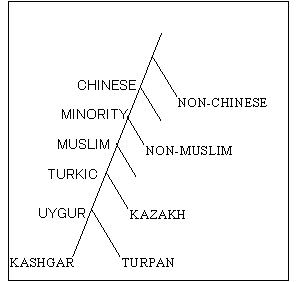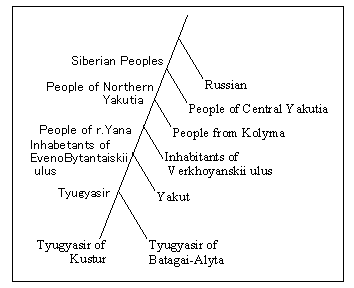| Figure 1 |
| The Lineage System of the Nuer [Evans-Pritchard 1940:193] |
 |
This approach can be roughly diagrammed for heuristic purposes as an articulating hierarchy of relational alterities, a schematic that segmental kinship theorists have been playing with for some time. For example, when "A" and "B" encounter a higher level of opposition "D", they form "C", moving a node up the scale to form higher-level relations, or conversely, down the scale when the higher-level threat subsides. While this scheme is binary, it is always constructed in a field of social relations, and is inherently ternary in that A and B are always in union or opposition depending on their interaction with D. [Gladney1996:455-456] (see Fig. 2)
|
Figure2 Articulating Hierarchy of Relational Alterities[Glandney 1996:455] |
Figure3 The Relational Alterities of Hui(Dungan)[Gladney 1996:457] |
 |
 |
| Figure4 The Relational Alterities of Uygur [Gladney 1996:460] |
Figure5 The Relational Alterities of Kazakh [Gladney 1996:467] |
 |
 |
While Evans-Pritchard's study was mired in the nineteenth century colonialist structuralism which portrayed "tribal" pastoralists as pre-modern and over-determined by tradition, his model of alterity is surprisingly relevant to the post-modern, post-cold war period, where it could be argued the world is becoming increasingly acephalus and breaking down into smaller and smaller relational units. These relations, like Evans-Pritchard's Nuer, are segmentary in principle, taking as their basic components not the face-to-face herding units, but the imagined community of the nation, and its constituent parts. [Gladney1996;454-455]
The Relational Alterities of Tyugyasir in Eveno-Bytantaiskii Ulus

Partial Overlap Model of Identity of the Peoples of Northern Yakutia

References
Aммoсoв, И. A. (Ammosov, I. A.),
1997, O языkoвoй сиtуации Tюгясирского рода эвенов Верхоянья Researching the Coexistence of Nationalities (2), Slavic Research Center, Hokkaido University, Sapporo (In Print).
Anderson, David G.,
1992, Property Rights and Civil Society in Siberia: an Analysis of the Social Movements of the Zabaikal'skie Evenki, Praxis International, Vol. 12, No. 1.
Evans-Pritchard, E.E.,
1940, The Nuer, A Description of the Modes of Livelihood and Political Institutions of a Nilotic People, The Clarendon Press, Oxford.
Gladney, Dru C.,
1996, Relational Alterity: Constructing Dungan (Hui), Uygur, and Kazakh Identities across China, Central Asia, and Turkey, History and Anthropology, Vol. 9, No. 4, pp. 445-477.
Лeвин, M. Г. (Levin, M. G.),
1956, Эвены,в кн.:Лeвин, M.Г.и Пoтaпoв, Л.П.(рeд.), Нaрoды Сибири, Издательство Академии Нaук СССР,Москва,и Ленинград. (The English translation was published in 1964 under the title of Peoples of Siberia by the University of Chicago Press in Chicago.)
Пaтkaнoв,С.(Patkanov, S.),
1906, Oпыт гeoграфии и статистики тунгуsсских племен Сибирина основаии данных пtереписи данных переписи населения 1897 г. и друихисточников,Записки Императорского Русского Географического Общества по Общества по отделению этнографии,том ХХХI,част I.
Смoляk,A.В. (Smoliak,A.V.),
1975, Этнические пpoцессы у народов Нижнегo Aмура и Сaxaлина,Издательство «Наука»,Москва.